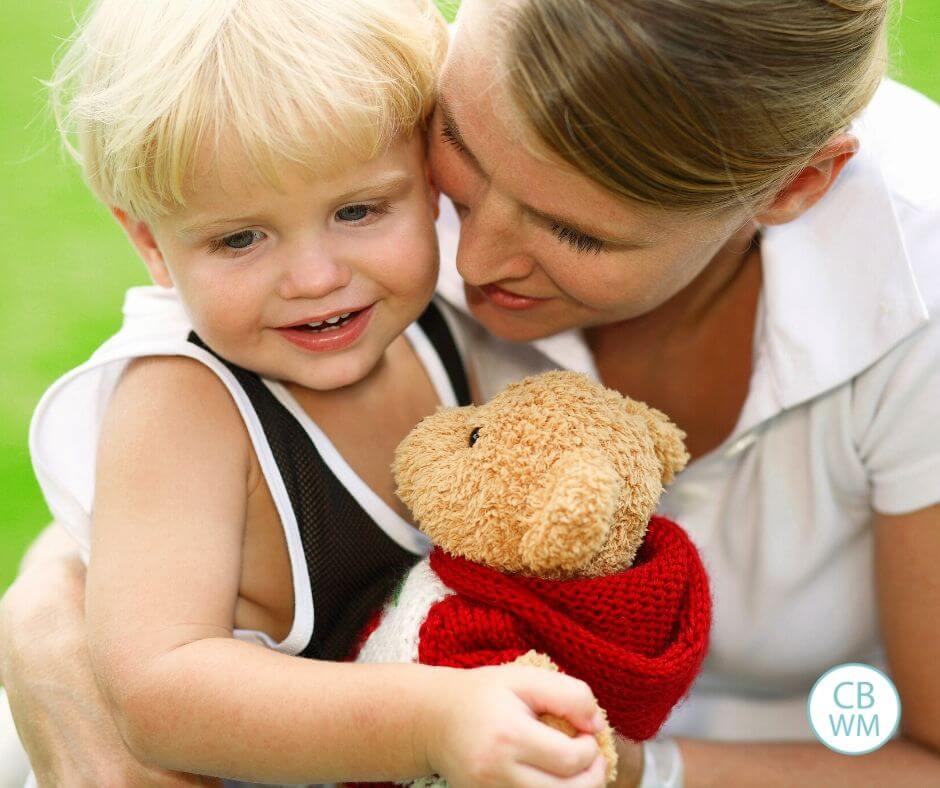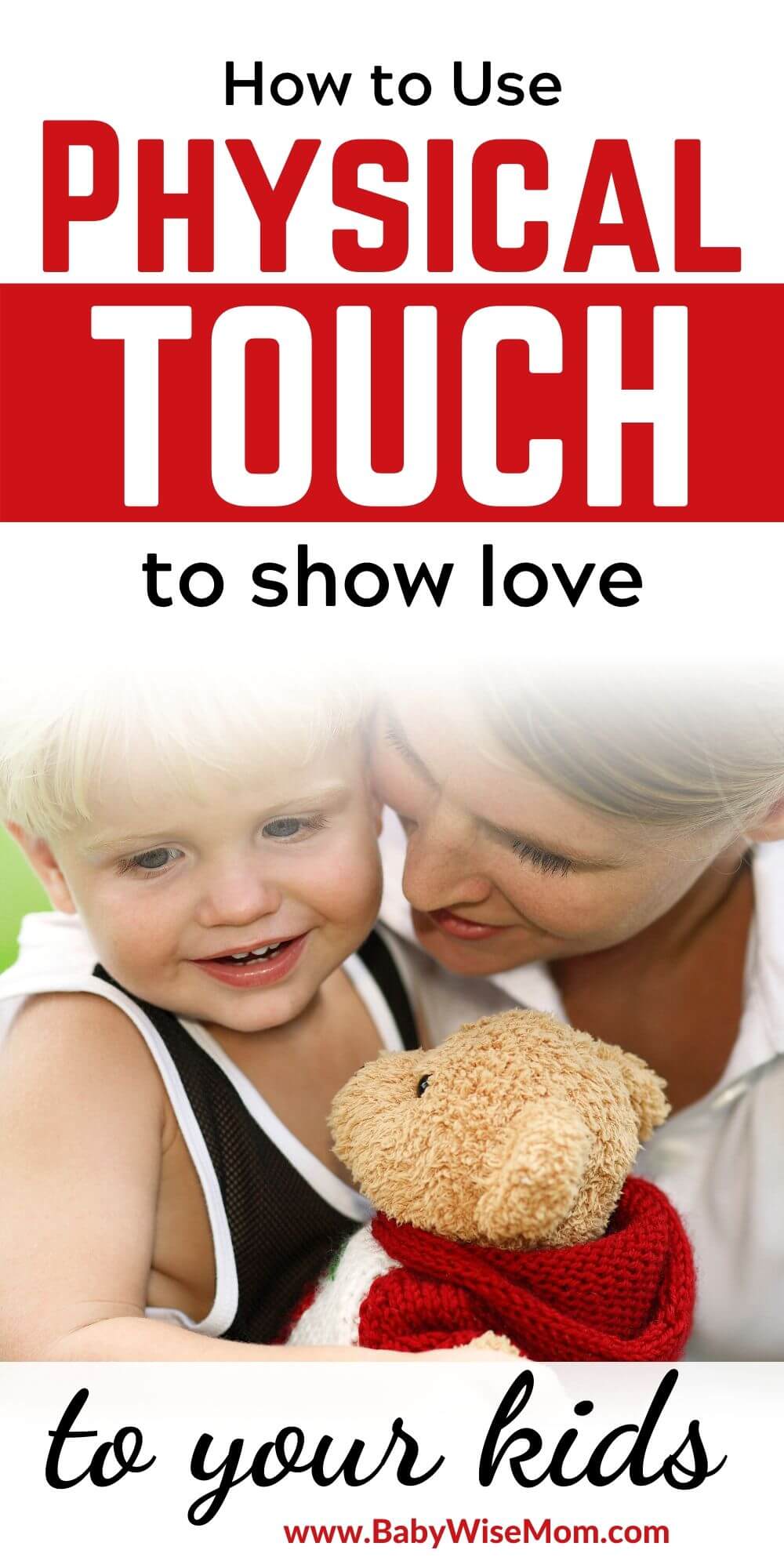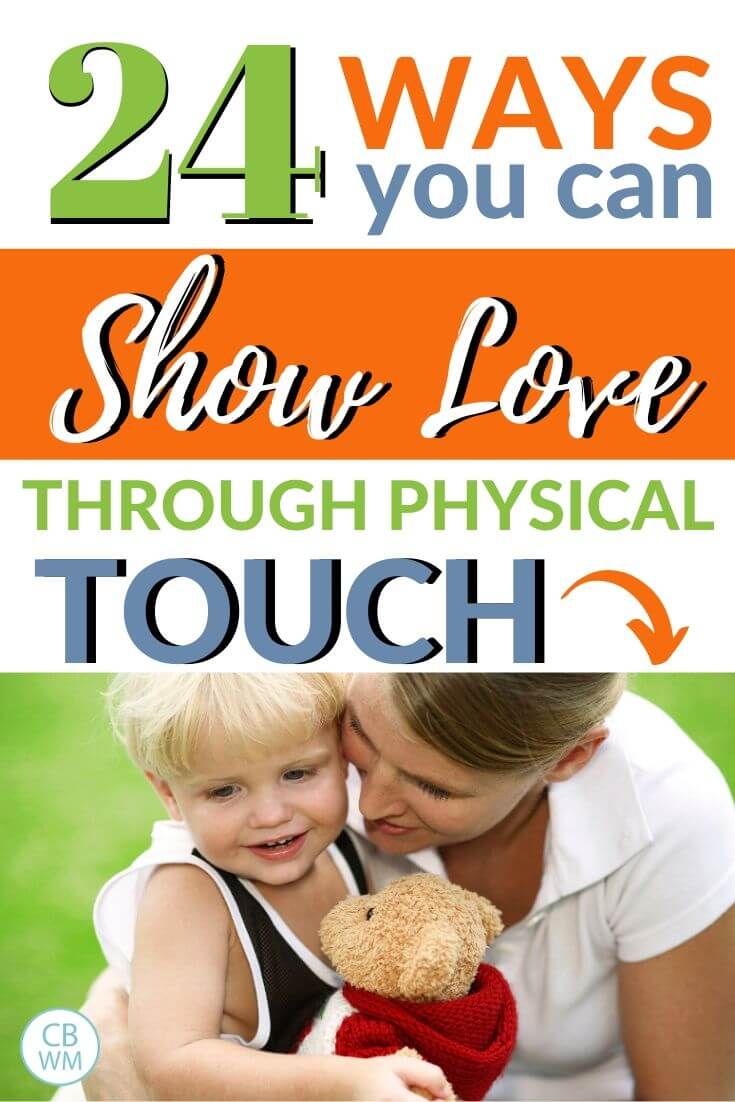Physical touch is one of the five main ways to show your child love. Learn how to show love through physical touch and help your child feel loved.

Did you know there are five different love languages? People tend to feel loved primarily in one of five ways and they show love primarily in one of five ways (these two are not often the same way).
I have long loved the book The Five Love Languages of Children as well as their book for adults. These two books help me know how to help my children feel loved, how to recognize what I need to feel loved, and how to help my husband feel loved.
Read: Identifying Your Child’s Primary Love Language
The first love language discussed in The Five Love Languages of Children is Physical Touch.
Post Contents
What is Physical Touch
The idea of physical touch is probably pretty straight forward. It is also probably quite easy for you to figure out how to provide physical touch for your child.
With younger children, you fulfill this need whether you want to or not. You are carrying, dressing, holding, rocking, bathing, etc. your child all day long.
As your child continues to get older, however, you will need to make more effort.
If you are like me, physical touch isn’t your natural way of showing love. If you child is like Brayden, he doesn’t seem to care if he gets physical touch or not, and might even sometimes pull away when you try to kiss him 100 times in 10 seconds.
As a side note, this book states that between/around age 7-9, boys typically start to resist physical touch (page 33). They still need it all through their growing up years, and lives.

Physical Touch is Important for Everyone
Keep in mind that all children need to be touched in loving ways.
“Physical touch is one of love’s strongest voices” (page 31). “All children need to be touched” (page 31).
The Five Love Languages of Children
This is true even if the primary love language is not physical touch. Children need to be multi-lingual in the love languages.
Something like a hug expresses love to all children, though it does shout love to those who have physical touch as their primary love language (page 37).
“Babies who are held, hugged, and kissed develop a healthier emotional life than those who are left for long periods of time without physical contact” (page 31).
The Five Love Languages of Children
Physical touch is especially important at times of sickness, pain physically, pain emotionally, fatigue, or when something funny or sad has taken place (page 34).
Your child might need extra physical touch right now, even if physical touch is not high on his/her typical needs.
For girl’s, the need for physical touch is very very big–especially from their fathers (page 34).
One thing to note is that for a child for whom physical touch is the primary love language, physical touch out of anger can be detrimental according to Chapman and Campbell (page 37). That means you want to avoid any discipline through physical touch.
Ideas For Showing Love Through Physical Touch
- Give hugs
- Hug for greetings and good-byes
- Kiss for greetings and good-byes
- Kneel down on child’s level for hugs
- Allow children to have a soothie (blanket, stuffed animal, etc.) for comfort
- Stroke head/hair
- Cuddle
- Hold child in lap
- Hug and Kiss good-night
- Back rubs. Chapman and Campbell suggest doing this especially when child is telling you about something upsetting
- After discipline, give hugs to show child discipline was based on consequences for the child’s actions but you still love your child.
- Cuddle while watching TV
- High fives for positive behavior and good jobs
- Give gifts that are touch-oriented, like pillows, blankets, or sweaters
- Tickle (as long as your child enjoys it)
- Play sports and games that require physical touch. This allows for natural touching
- Cuddle while reading stories. For younger children, have the child on your lap
- Toss baby in air
- Touch arm or shoulder often
- Sing songs together that require touching and action like clapping, spinning, or jumping
- Give extra cuddles when child is sick
- Family group hugs
- Give kisses even if child is “too old” by his standards
- Baths, dressing, carrying
One note, I once read that when you give your child a hug or your child hugs you, do not be the first to let go. Wait until your child lets go before you do. This enables them to get the physical touch they need.

Personal Observations at Our House
Of my four children, only Brinley ranks high on needing physical touch. The Five Love Languages of Children book has a short quiz at the end, which you can use to find out what your child’s primary love language is. This is really not accurate until age 5 or older.
It is only one point off of being her highest. It is obvious that she loves and needs a lot of physical touch.
The first thing she does each day is run to me and cuddle up next to me. She loves hugs and makes sure she takes advantage of our hugging rule for her siblings each day. A simple game of tag thrills her. Anyone she has an affinity for is a recipient of her hugs.
Even as a baby, often all she needed when upset was for me to simply touch her.
But remember, all kids need some physical touch even if it is not high on their scale.
I remember my kids when they were young.
Physical touch has never been a high need for Brayden, and I could tell that from the time he was a baby.
His physical touch needs were always provided for in our natural and necessary interactions.
Even so, he still loved some physical touch, as this book indicates. I remember when he was 4 and approaching age 5. He always wanted a kiss and hug from whomever was leaving the house–or from me if it was him leaving. This is true even when he is just going next door to play.
Brayden loved to get a hug first thing each morning. He also loved to cuddle while reading stories at night.
Each night after we read stories and had family prayer, Brayden and I cuddled on the couch and talked about the day.
It lasted for maybe five minutes. It wasn’t long. He loved it, and we had many powerful, though short, conversations doing this.
I always made sure to give some sort of rub on the arm or hug when correcting him. If it was a serious offense, I tended to hold him on my lap.
He loved to do high-fives for good jobs. If I saw him exercising great restraint or self-control, I rubbed his head.
Kaitlyn was quite different. If she wasn’t getting enough physical touch, she made sure we knew it. She often asked to be held or to simply sit in my lap. She loved it when I was pregnant with McKenna. I sat a lot, and she sat right with me.
Kaitlyn adored games like ring around the rosie. She loved high fives, hugs, and kisses.
She liked for me to run my fingers through her hair. She also liked hugs and kisses. She would often come to me, hug me and say, “I love you so much Mama.” If I hugged her spontaneously, she always giggled and said, “I love you, too.”
Kaitlyn had many stuffed animals. She wasn’t attached to them in a strange way, but she loved to carry them around. She loved to be tickled.
She often asked to be carried around. This wasn’t because she was lazy or wanted to be treated like a “baby.” It was because she wanted to be held.
The interesting thing is that as Kaitlyn has gotten older, she has gotten less and less interested in physical touch.
McKenna loved (and loves) to wrestle. She loves big hugs and a back rub can calm her down almost instantly. She is the entire reason our hugging rule was started.
It is worth noting that I have my kids take this quiz every few years. Many love languages stay the same or similar, but there have been big changes, also. For example, the most recent time Kaitlyn took the quiz, she scored only 1 point for physical touch, while the time before that, she scored 5.
Conclusion
Physical touch is important to all children and to all people. I can see the importance in the lives of my children, even the ones who don’t seem that interested overall.
Don’t underestimate the power and importance of physical touch for your children. There is much more of value in this chapter, especially for older children.
Remember, children need MORE physical touch in times of stress or sadness. Remember that in our current climate.
I have said it in the past, but I really think every parent needs to read this book.

Related Posts
- Love Language: Acts of Service
- Love Language: Quality Time
- Love Language: Gifts
- Love Language: Words of Affirmation
- 3 Ways to Show Your Child Unconditional Love
